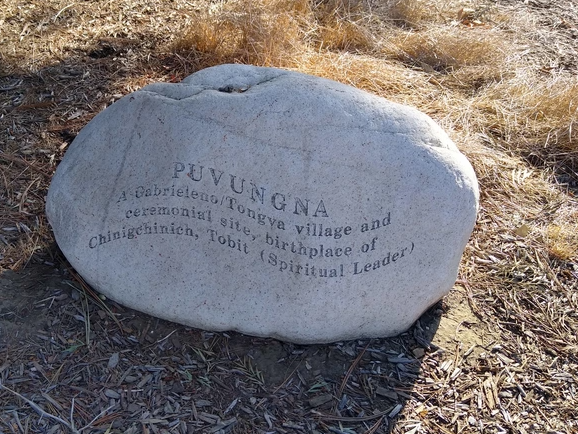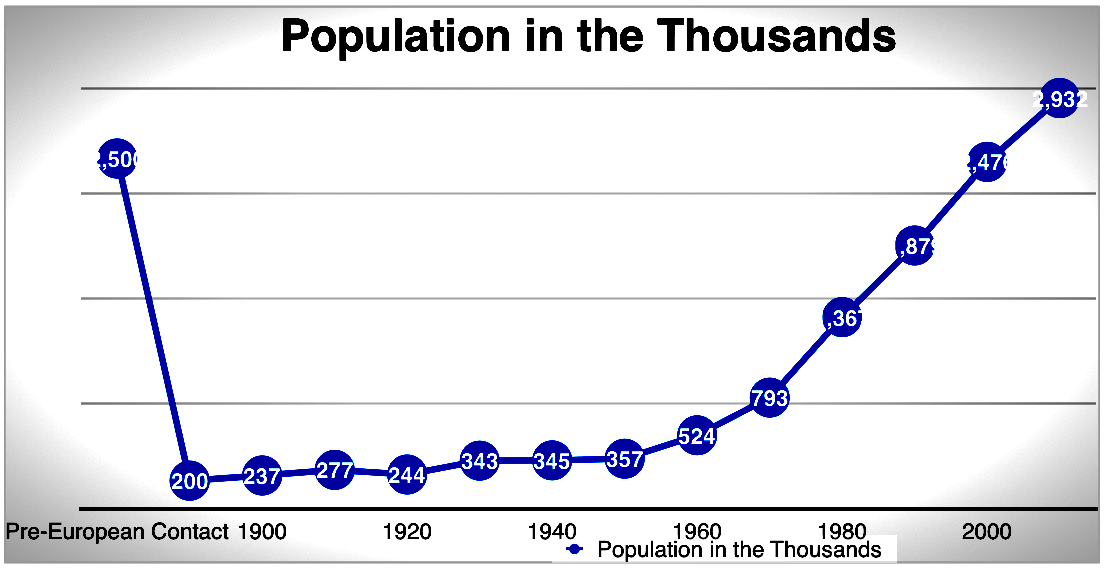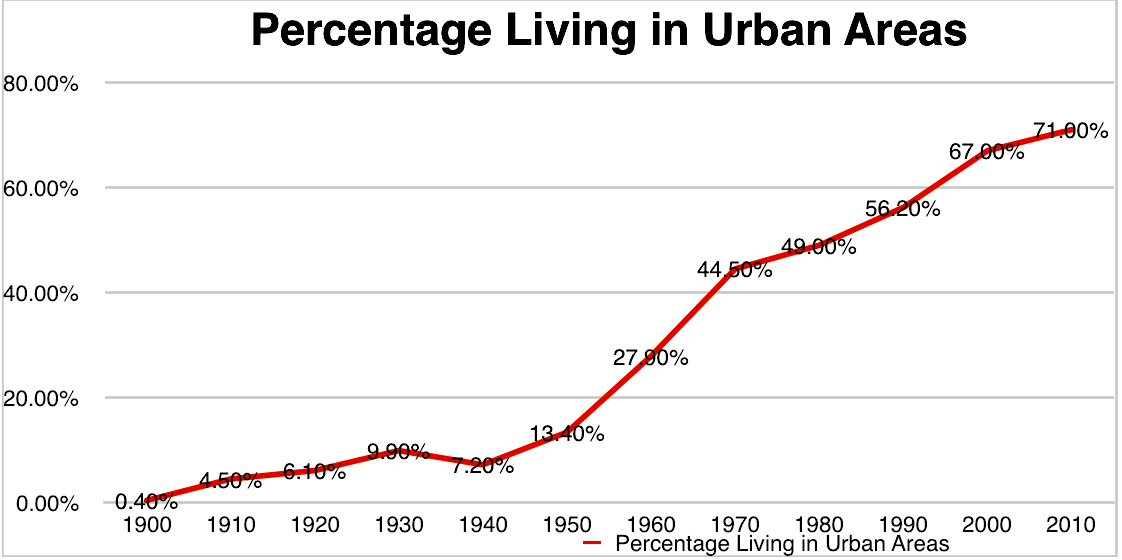5.1: History and Demographics
- Last updated
- Save as PDF
- Page ID
- 104056

- Erika Gutierrez, Janét Hund, Shaheen Johnson, Carlos Ramos, Lisette Rodriguez, & Joy Tsuhako
- Long Beach City College, Cerritos College, & Saddleback College via ASCCC Open Educational Resources Initiative (OERI)
Land Acknowledgement
"That was our hunting ground and you have taken it from us. This is what sits heavy [on our hearts] and the hearts of all nations." - Cornstalk, Shawnee chief
The greatest struggle for American Indians has been over their land. To understand this struggle is to understand our genocidal history and the role we have played and continue to play in systems in which power and resources, such as land, are distributed unequally. This chapter will begin by acknowledging that Long Beach, California is Kizh and Tongva land. Puvungna are tribal lands where sacred Tongva villages historically existed in what is now Long Beach, California. Unfortunately, these historical and archeological sites are under threat of or have been developed rather than being preserved per the efforts of the Tongva people (Loewe, 2016; Saltzgaver, 2020). Let us take into consideration the struggles that have occurred on these lands and honor the Indigenous peoples that sustain them.

If you are interested in finding out what Indigenous lands your U. S. city are on, please text your city name and state (e.g., Long Beach, California) to (907) 312 - 5085. This chapter will use the terms Native Americans and AI/AN (American Indian/Alaska Natives) given that there is no specific consensus among scholars regarding terminology. Moreover, some Indigenous people prefer to be identified by their Nation. Lastly, the concept of Indigenous, people who live or have lived within the past several centuries in non-state societies, will be utilized to discuss people and cultures that existed in the United States prior to European contact.
Background in America
American Indians have been on this continent much longer than any other racial or ethnic group. According to the Bering Strait theory, sometime between 17,000 and 30,000 years ago, hunter-gatherers from Siberia came across the frozen Bering Strait, or across a land bridge formed during the Ice Age, in search of game. Over the millennia, they became the people we call Native Americans or American Indians. They are the Indigenous people of the North and South American continents (Dunn, 2010). However, this theory has been challenged from both from a philosophical angle (Deloria, 1995) and from new research uncovered from an evolutionary genetic approach (Daley, 2016; Ewen, 2017).
Pre-European Contact
It is difficult to determine how many Native Americans existed in the United Stated prior to European contact. Emmanuel Domenech (1860) estimated that the Native American population pre-European contact was between 16 to 17 million people. Years later, a more generally accepted scientific estimate was provided by James Mooney (1928) in which he estimated that the North American "aboriginal" population was 1.2 million at the onset of European contact. A more recent estimate has been provided by Matthew Snipp (1986) in which he places the pre-European contact population from 2 to 5 million. The population figures discussed are only estimates and some scholars suggest that the Indigenous American population pre-European contact was larger than the last estimate Snipp (1986) provided.
Post-European Contact
Race and ethnicity have torn at the fabric of American society ever since the time of Christopher Columbus, when about 1 million Native Americans were thought to have populated the eventual United States. By 1900, their numbers had dwindled to about 240,000, as tens of thousands were killed by white settlers and U.S. troops and countless others died from disease contracted from people with European backgrounds. Scholars have stated that this mass killing of Native Americans amounted to genocide (Wilson, 1999).
European colonization of the Americas was detrimental to the Indigenous populations. Colonization is the act of taking land by a foreign group or nation, most frequently through force, and then settling in the newly acquired territory which displaces the original Indigenous people to those lands. War, famine, forced removal, lack of immunity to European diseases, and the exploitation of this lack of immunity as intentional "biological" warfare, such as blankets infected with diseases, decimated American Indians (Snipp, 1989). Using the estimates mentioned above and U. S. Census data, Figure 5.1.2 below shows the early dramatic decrease and gradual recent increase of the Native American population, specifically American Indian and Alaska Native (AI/AN) alone (meaning not mixed with other race-ethnic groups).
In the United States, settler-colonialism is the specific type of colonization practiced. According to Morris (2019), "We can begin by defining settler-colonialism as it relates specifically to Indigenous peoples of North America. The goal of settler-colonization is the removal and erasure of Indigenous peoples in order to take the land for use by settlers in perpetuity." Once lands have been colonized, European settlers move into the lands usually cleared by European colonizers and further expanded these settlements both spatially and temporally. This results in the continued and, most frequently, permanent displacement of Indigenous communities from their ancestral homelands.

Reservations
Concerning modern American Indians, Gary Sandefur, a professor of social work and sociology at the University of Wisconsin-Madison and an affiliate of the Institute for Research on Poverty writes:
How American Indians came to be concentrated on reservations is a complicated story that most Americans know only very little about from their courses in American history in high school and college. The isolation and concentration of American Indians began very early, but it received its first legal justification in the Indian Removal Act of 1830. Subsequent to the passage of this legislation, most of the Indians who were located east of the Mississippi were relocated to areas west of the river...Toward the end of the nineteenth century, the federal government revised its principal approach to the "Indian problem" to one of forced assimilation rather than forced isolation. This change in policy was in part motivated by awareness that the quality of life on the isolated reservations was very, very low. The concerns about the reservations resembled in many respects the current analyses of problems in the central city...The next major attack on the reservation system occurred in the early 1950s. Public opinion and political leaders were distressed by the miserable living conditions on Indian reservations, on the one hand, and the special legal relationship between American Indian groups and the federal government, on the other hand. In 1953, termination legislation was passed and signed into law. The intent of this legislation was to end the special relationship between Indian tribes and the federal government. Reservations would cease to exist as independent political entities...Since the 1950s the proportion of the American Indian population living on reservations has declined from over 50 percent to approximately 25 percent in 1980. This decline has been due to the migration of American Indians away from these impoverished, isolated areas. In 1980, 336,384 American Indians lived on reservations. Although some of these reservations are quite small, 250,379 Indians lived on 36 reservations with populations of 2,000 or more. Three-quarters of these Indians lived on the 18 reservations that had poverty rates of 40 percent or higher. In other words, approximately 14 percent of all American Indians in 1980 lived on large reservations with poverty rates of 40 percent or higher (Sandefur, 1989).
Though most AI/AN do not live on reservations, the table below conveys the largest reservations.
| American Indian Reservation | American Indian or Alaska Native (Alone or in Combination) |
|---|---|
| Navajo (AZ, NM, UT) | 169,321 |
| Pine Ridge (SD, NE) | 16,906 |
| Fort Apache (AZ) | 13, 014 |
| Gila River (AZ) | 11,251 |
| Osage (OK) | 9,920 |
| San Carlos (AZ) | 9,901 |
| Rosebud (SD) | 9,809 |
| Tohono O'oodham (AZ) | 9,278 |
| Blackfeet (MT) | 9,149 |
| Flathead (MT) | 9,138 |
Demographics
The only fully nonimmigrant ethnic group in the United States, Native Americans once numbered in the millions but by 2010 made up only 0.9 percent of U.S. populace (U.S. Census, 2010). Currently, about 2.9 million people identify themselves as Native American alone, while an additional 2.3 million identify themselves as Native American mixed with another ethnic group (Norris, Vines, & Hoeffel, 2012).
| Alone | Alone or in combination (two or more groups) | |
|---|---|---|
| All American Indians and Alaska Natives | 2,932,248 | 5,220,579 |
| American Indians | 2,164,193 | 3,631,571 |
| Alaska Natives | 122,990 | 168,786 |
There are about 3 million Native Americans currently living in the US. Their tribal affiliations (as of census 2000) are 16% Cherokee, 12% Navajo, 6% Chippewa, 6% Sioux, 4% Choctaw, 46% all other tribes; the ten largest nations are detailed in the table below. Less than 2% of the US population is Native American with 22.3% living on reservations and trust lands; 10.2% living in tribal jurisdiction statistical areas; 2.7% in tribal designated statistical areas; 2.4% in Alaska native village statistical areas. However, the largest group of American Indians, 62.3%, do not live on traditional tribal lands or reservations. The geographical distribution is as follows: 6.25% of all American Indians live in the Northeast U.S., 17.93% of all American Indians live in the Midwest U.S., 30.21% of all American Indians live in the Southern U.S., and 45.59% of all American Indians live in the Western U.S. (U. S. Census Bureau).
| Tribal Grouping | One Tribal Grouping Reported |
|---|---|
| 1. Navajo | 286,731 |
| 2. Cherokee | 284,247 |
| 3. Ojibwa/Chippewa | 112,757 |
| 4. Sioux | 112,176 |
| 5. Choctaw | 103,916 |
| 6. Apache | 63,193 |
| 7. Lumbee | 62,306 |
| 8. Pueblo | 49,695 |
| 9. Creek | 48,352 |
| 10. Iroquois | 40,570 |
Native Americans speak: English, Spanish, French, and over 150 Native Languages and thousands of dialects. American Indians come from: United States, Mexico, Canada, Central America, South America. Although some Indigenous languages have survived, there are several languages that are at risk of becoming extinct. While it is difficult to estimate how many Indigenous languages have been lost, a recent estimate suggests that in the United States, it has been at least 125 languages (Koyfman, 2017).
| Tribal Grouping | One Tribal Grouping Reported |
|---|---|
| 1. Navajo | 169,471 |
| 2. Yupik (Alaska) | 18,950 |
| 3. Dakota (Sioux) | 18,616 |
| 4. Apache | 13,083 |
| 5. Keres (Pueblo) | 12,495 |
| 6. Cherokee | 11,610 |
| 7. Choctaw | 10,343 |
| 8. Zuni | 9,686 |
| 9. Ojibwa | 8,371 |
| 10. Pima | 7,270 |
Currently, Native Americans are more likely to live in a city rather than a reservation, as the figure conveys below. The trend towards urbanization began to increase after the passage of the 1934 Indian Reorganization Act, then dropped a bit leading up to the 1953 Termination Act. Urbanization then sharply increased in the 1950s with multiple government programs created to encourage Native Americans to move to the cities, such as the establishment of American Indian Centers and after 1962, the Employment Assistant Program (Healey & O'Brien, 2015; Schaefer, 2015).

The urbanization trend is supported by the 2010 U. S. Census data which indicates that U. S. cities hold the largest number of Native Americans, as shown in Table 5.1.8. California is the state with the largest Native American population.
| Place | Alone or in Combination | |
|---|---|---|
| 1. New York City | 111,749 | |
| 2. Los Angeles | 54,236 | |
| 3. Phoenix | 43,724 | |
| 4. Oklahoma City | 36,572 | |
| 5. Anchorage | 36,062 | |
| 6. Tulsa | 35,990 | |
| 7. Albuquerque | 32,571 | |
| 8. Chicago | 26,933 | |
| 9. Houston | 25,521 | |
| 10. San Antonio | 20,137 |
Assuming these demographic trends continue as conveyed in USA Facts, the Native American population will continue to rise, demonstrating American Indian resilience.
Contributors and Attributions
- Gutierrez, Erika. (Santiago Canyon College)
- Hund, Janét. (Long Beach City College)
- Sociology (Barkan) (CC BY-NC-SA 4.0)
- Minority Studies (Dunn) (CC BY 4.0)
- Introduction to Sociology 2e (OpenStax) (CC BY 4.0)
Works Cited
- Aguirre, A., Jr. & Jonathan, H.T. (2004). American Ethnicity: The Dynamic and Consequences of Discrimination. 4th ed. Boston, MA: McGraw-Hill.
- Cook. R. (n.d.). Heart of Colonialism Bleeds Blood Quantum.
- Daley, J. (2016). First humans entered the americas along the coast, not through the ice. Smithsonian Magazine.
- Deloria, V., Jr. (1995). Red Earth, white Lies. New York, NY: Scribner's.
- Domenech, E. (1860.) Seven Years Residence in the Great Deserts of North America. London, UK: Longmans.
- Ewen, A. (2017). The Bering Strait Theory. New York, NY: Indian Country Today.
- Healey, J. F. & Eileen O. (2015). Race, Ethnicity, Gender and Class: The Sociology of Group Conflict and Change. 7th ed. Los Angeles, CA: Sage.
- Koyfman, S. (2017). What was, and what is: Native American languages in the us. Babbel Magazine.
- Loewe, R. (2016). Of Sacred Lands and Strip Malls: The Battle for Puvungna. New York, NY: Rowman & Littlefield.
- Mooney, J. (1928). The Aboriginal Population of America North of Mexico. Washington, D. C.: Smithsonian Institution Miscellaneous Collections, 80:7.
- Morris, A. (2019). What is settler-colonialism? Teaching Tolerance.
- Norris, T., Vines, P.L., and Hoeffel, E.M. (2012). The American Indian and the Alaska Native population:2010. C2010BR-10.
- Saltzgaver, H. (2020). Dirt dumped on Puvungna at cal state long beach prompts lawsuit. The Grunion.
- Sandefur, G.D. (1989). American Indian reservations: the first underclass areas? Focus 12 1:37-41.
- Schaefer, R.T. (2015). Racial and Ethnic Groups. 14th ed. Boston, MA: Pearson.
- Siebens, J. &Tiffany, J. (2011). Native North American Languages Spoken at Home in the United States and Puerto Rico: 2006-2010. ACSBF/10-10.
- Snipp, M.C. (1986). The changing political and economic status of the American Indians: From captive nations to internal colonies. American Journal of Economics and Sociology 45, 145-57.
- Snipp, M.C. (1989). American Indians: The First of This Land. New York, NY: Russell Sage Foundation.
- Spinden, H. (1928). The population of ancient America. Geographical Review 18,640-60.
- Thornton, R. (2001). Trends among American Indians in the United States. In N. Smelser, W. Wilson, and F. Mitchell (Eds.), America Becoming: Racial Trends and Their Consequences (1:135-69).Washington, D. C.: National Academy Press.
- United States Census Bureau. (2010). Statistical Abstract of the United States, 2010.
- Wilson, J. (1999). The Earth Shall Weep: A History of Native America. New York, NY: Atlantic Monthly Press.

